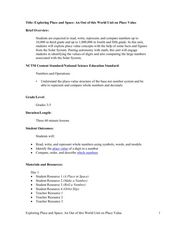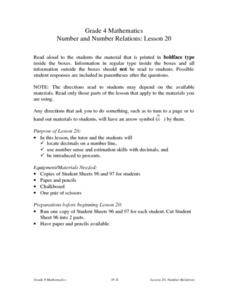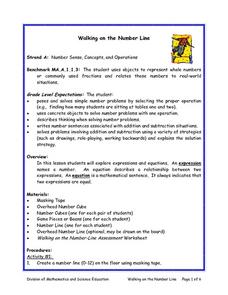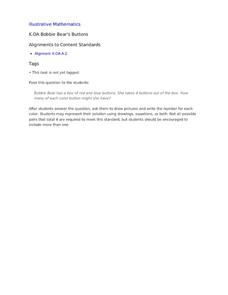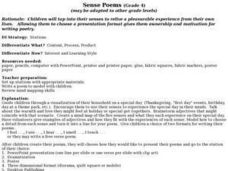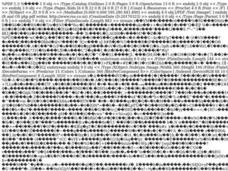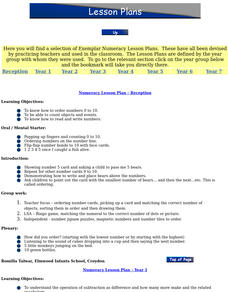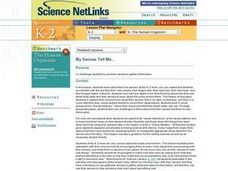Curated OER
Making Cents of the Senses
Students explore sight and hearing. In this senses lesson, students read Brown Bear Brown Bear, discuss how eyes are used for sight, and chart the eye color of the students in the class. Students discuss how hearing is important, take a...
Curated OER
Exploring Place and Space
Students explore number values by completing mathematical worksheets in class. In this decimals lesson, students identify the different place values a number has and the use of decimals to represent a fraction of a number. Students...
Illustrative Mathematics
Christina's Candies
Help Christina figure out how many chocolate and lemon candies she has with a lesson on decomposing numbers. When presenting this context to the class, the teacher chooses the total number of candies and the number that are chocolate,...
Curated OER
Number and Number Relations: Lesson 20
Fourth graders locate decimals on a number line. They use number sense and estimation skills with decimals. Students are introduced to percents. They look at fractions on a number line. Students fold a piece of paper to find halves,...
Curated OER
Comparing/Ordering Numbers
Third graders compare numbers. In this math instructional activity students compare ones, tens, and hundreds. They also order numbers from least to greatest and from greatest to least.
Curated OER
Walking On The Number Line
Learners investigate the concepts of expressions and equations while defining the similarities and differences. They explore the operations by using a number line and record answers while working with the teacher. Students play the game...
Illustrative Mathematics
A Bobbie Bear's Buttons
Young mathematicians help Bobbie Bear pick colored buttons out of a box as they learn how to decompose numbers less than 10 into pairs of smaller numbers. To support learners with the process, consider creating a worksheet or graphic...
Curated OER
Your Five Senses
Students identify the five senses. In this biology lesson, students participate in an experiment and use their five senses to identify various substances.
Curated OER
Sense Poems
Young scholars explore 5 senses poetry. In this poetry writing instructional activity, students visualize a special day and brainstorm related vivid adjectives and phrases. Young scholars create mindmaps of the five senses to...
Curated OER
Focusing on Imagery through your Senses
Students enrich their writing of an original scene by incorporating imagery, visual pictures and scenes painted in the readers mind by using one of their senses as a unique writing tool.
Curated OER
One of Our Five Senses - Touch
The wonderful world of Oobleck is entered in order to awaken your learner's sense of touch! As a warm up, learners put their hands in mystery bags in order to identify things that are wet, dry, hot, cold, hard, soft, rough, and smooth....
Curated OER
Using Negative Numbers
Fourth graders explore negative numbers with this resource. They discuss positive and negative numbers by counting who is present and absent, placing numbers on a number line, and graphing temperatures. Using a variety of activities,...
Curated OER
Understanding Place Values
Students investigate the place values of numbers by completing a worksheet. In this number sense lesson, students identify the place value of a number from ones, to the millions. Students complete a place value worksheet in...
Curated OER
Number Operations
Students investigate integers and solve problems using integers. In this algebra instructional activity, students solve problems to help improve speed and accuracy of mental math. They develop a deeper knowledge of the way integers are...
Curated OER
Numeracy Lesson Plan: Reception
Students examine number sense by participating in identification activities. In this number value instructional activity, students practice counting from 1-10, identifying number flash cards, reading clocks and multiplying basic numbers....
Ohio Department of Education
Fraction Models - Grade Three
Explore fractions using different manipulatives and illustrations. Your class can create a variety of models of fractions and mixed numbers with drawings and manipulatives. They then work to compare fractions, mixed numbers, and whole...
Curated OER
Subtraction
Students explore subtraction. In this mathematics lesson, students practice how to subtract numbers from 20, 100 and other whole numbers. Students realize that there are number bonds which can help with subtraction like 3 and 17 bonds to...
K20 LEARN
It’s My Party and I’ll Hear What I Want To: Gatsby’s Party Playlists, The Great Gatsby and the Sense of Sound
Young scholars consider how film soundtracks can help support not only the mood but also the tone of a scene. After viewing two very different trailers for the same film, class members create their own soundtracks for two party...
Curated OER
Find 1
Extend your class's ability to represent unit fractions on a number line with this challenging worksheet. Given two number lines, one labeled with zero and 1/4, the other with zero and 5/3, learners must accurately locate the number one...
K20 LEARN
The Eyes of Dr. T. J. Eckleburg: The Great Gatsby and the Sense of Sight
To conclude a study of The Great Gatsby, class members create a multimodal project that represents what they feel the eyes of Dr. T.J. Eckleburg see about the hidden side of one of the characters in F. Scott Fitzgerald's classic...
Curated OER
Number Recognition Games
Students explore number sense by participating in a math recognition activity. In this number identification lesson, students practice pronouncing names of numbers and matching the number with an amount of objects. Students practice...
Curated OER
Krypto Math Game
Students play a math game. In this number sense and mental math lesson, students play a game where they use mental math to form equations that result in the target number required to win the game.
Curated OER
My Senses Tell Me...
Learners work at "Sense Stations" to explore each of the five senses.
Curated OER
Making Sense of Our Senses
Students participate in activities about the five senses. They explore objects, listen to stories and discuss the senses with classmates.

